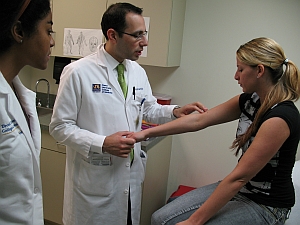Young People Are the Focus of Indoor Tanning Regulation
April 2, 2010

More than 30 million people tan indoors every year and nearly three quarters of them are women between ages 16 and 29, according to the Journal of the American Academy of Dermatology.
The Food and Drug Administration's General and Plastic Surgery Devices Panel recently met to discuss tightening the regulations in place for tanning beds. One of the recommendations talked about was a ban on the use of tanning beds by people under the age of 18.
“It is 75 percent more likely for a person to develop skin cancer if they use a sun bed before the age of 35,” warns Mark Abdelmalek, MD, assistant professor in the Department of Dermatology and chief of the Division of Laser and Dermatologic Surgery at Drexel Dermatology. “This percentage refers to an increased risk of developing melanoma, the deadliest form of skin cancer and the second most common cancer in young adults.”
The FDA wants to change the classification of tanning beds from Class I to Class II or III. Class I products present minimal potential for harm, such as medical gloves and elastic bandages. Class II devices, such as x-ray machines, need more than just general rules to assure safety and effectiveness and therefore require special labels and mandatory performance standards. Devices in Class III categories have too little information to assure safety and effectiveness.
In July 2009, the World Health Organization elevated ultra violet radiation from tanning beds to a Group 1 carcinogen meaning "causes cancer in humans." This is the same category as tobacco and asbestos. The WHO recently added tanning beds to its list of the most dangerous forms of cancer-causing radiation.
“UV light is known to cause mutations in skin cells and research has shown a link between the development of melanoma and getting sunburned at a young age,” says Abdelmalek. “I always remind my patients to wear and reapply sunscreen throughout the day, and if they desperately want to look tan to use self tanners.” High-pressure tanning lamps used in tanning salons emit doses of UV-A up to twelve times that of the sun.
The new Health Care Reform Bill President Obama signed into law includes a 10 percent tax on people receiving indoor tanning services. The initiative is expected to generate $2.7 billion over 10 years to help fund the health care overhaul.
Currently, there is proposed legislation in the Pennsylvania Senate to limit indoor tanning for minors. It would prohibit children under age 14 from using a tanning device without a letter from a physician and require parental supervision during tanning sessions for those ages 14 to 18.
Regulated tanning salon legislation already exists in other states and countries. Germany recently banned indoor tanning for minors under the age of 18, becoming one of the first governments in the world to take such action. Brazil banned it for cosmetic purposes. Similar proposals are in the works in Australia and the United Kingdom. “There is no safe tan, whether it be from the sun or from tanning salons,” says Abdelmalek.